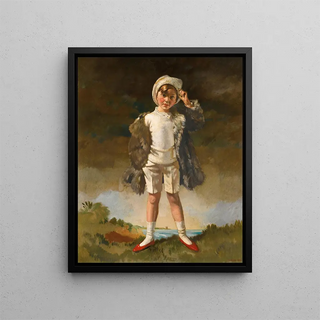Art print | Noll, fils d'Oliver St. John Gogarty - William Orpen


View from behind

Frame (optional)
In the vibrant universe of art, some works manage to capture the very essence of their era while transcending the limits of time. "Noll, fils d'Oliver St. John Gogarty" by William Orpen is one of those creations that fascinate and provoke thought. This depiction, imbued with realism and delicacy, immerses us in early 20th-century Ireland, a period marked by profound social and political changes. Through the penetrating gaze of young Noll, Orpen invites us to explore not only the face of an individual but also the soul of a nation in full transformation. This artwork, through its psychological depth and refined aesthetic, stands as a poignant testament to the aspirations and struggles of its time.
Style and uniqueness of the work
William Orpen's style is distinguished by a remarkable mastery of light and color, which give his portraits an almost lifelike dimension. In "Noll, fils d'Oliver St. John Gogarty," the chosen palette subtly evokes the nuances of youth while highlighting the complexity of human emotions. The texture of the clothing, the play of shadows on the young boy's face, all contribute to an atmosphere of closeness and intimacy. Orpen does not merely depict a face; he captures an essence, a story. Every brushstroke seems to tell an anecdote, every exchanged glance between the viewer and the subject becomes an invitation to reflection. This psychological realism, combined with impressionist sensitivity, makes this artwork a timeless masterpiece capable of touching everyone's heart.
The artist and his influence
William Orpen, an emblematic figure of British art, established himself as a preferred portraitist in the early 20th century. His training at the Royal Academy of Arts in London and his travels in France allowed him to incorporate diverse influences, from Impressionism to academic traditions. Orpen skillfully navigated between these currents, creating a style that is uniquely his own. His approach to portraiture goes beyond mere physical representation; it is an exploration of identities and hidden stories behind each face.

Matte finish

View from behind

Frame (optional)
In the vibrant universe of art, some works manage to capture the very essence of their era while transcending the limits of time. "Noll, fils d'Oliver St. John Gogarty" by William Orpen is one of those creations that fascinate and provoke thought. This depiction, imbued with realism and delicacy, immerses us in early 20th-century Ireland, a period marked by profound social and political changes. Through the penetrating gaze of young Noll, Orpen invites us to explore not only the face of an individual but also the soul of a nation in full transformation. This artwork, through its psychological depth and refined aesthetic, stands as a poignant testament to the aspirations and struggles of its time.
Style and uniqueness of the work
William Orpen's style is distinguished by a remarkable mastery of light and color, which give his portraits an almost lifelike dimension. In "Noll, fils d'Oliver St. John Gogarty," the chosen palette subtly evokes the nuances of youth while highlighting the complexity of human emotions. The texture of the clothing, the play of shadows on the young boy's face, all contribute to an atmosphere of closeness and intimacy. Orpen does not merely depict a face; he captures an essence, a story. Every brushstroke seems to tell an anecdote, every exchanged glance between the viewer and the subject becomes an invitation to reflection. This psychological realism, combined with impressionist sensitivity, makes this artwork a timeless masterpiece capable of touching everyone's heart.
The artist and his influence
William Orpen, an emblematic figure of British art, established himself as a preferred portraitist in the early 20th century. His training at the Royal Academy of Arts in London and his travels in France allowed him to incorporate diverse influences, from Impressionism to academic traditions. Orpen skillfully navigated between these currents, creating a style that is uniquely his own. His approach to portraiture goes beyond mere physical representation; it is an exploration of identities and hidden stories behind each face.






